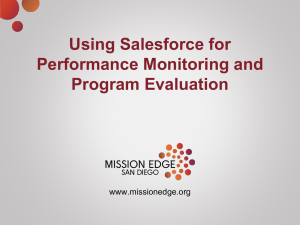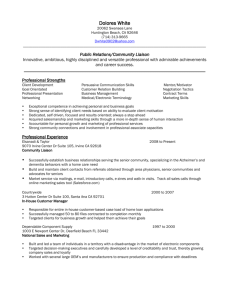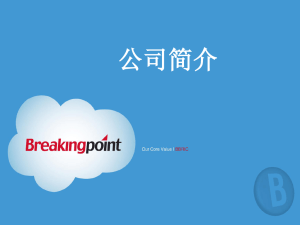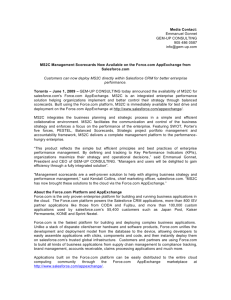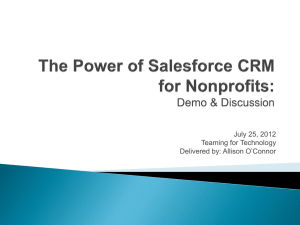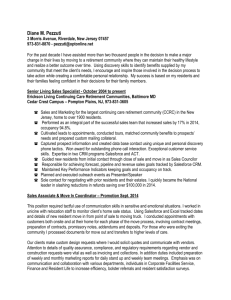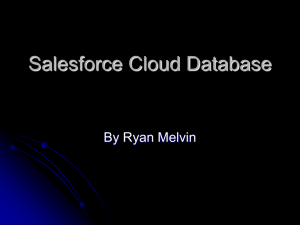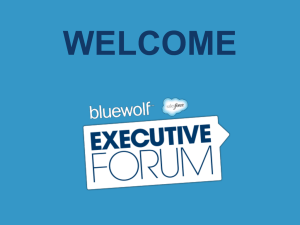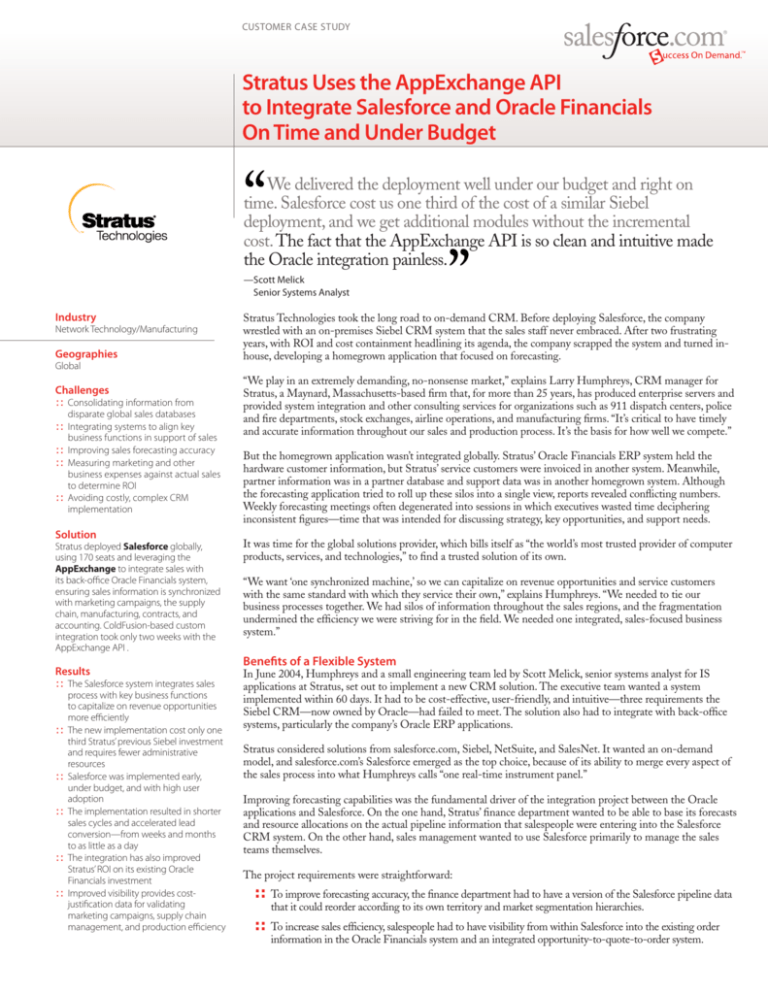
CUSTOMER CASE STUDY
Stratus Uses the AppExchange API
to Integrate Salesforce and Oracle Financials
On Time and Under Budget
We delivered the deployment well under our budget and right on
time. Salesforce cost us one third of the cost of a similar Siebel
deployment, and we get additional modules without the incremental
cost. The fact that the AppExchange API is so clean and intuitive made
the Oracle integration painless.
—Scott Melick
Senior Systems Analyst
Industry
Network Technology/Manufacturing
Geographies
Global
Challenges
:: Consolidating information from
disparate global sales databases
:: Integrating systems to align key
business functions in support of sales
:: Improving sales forecasting accuracy
:: Measuring marketing and other
business expenses against actual sales
to determine ROI
:: Avoiding costly, complex CRM
implementation
Solution
Stratus Technologies took the long road to on-demand CRM. Before deploying Salesforce, the company
wrestled with an on-premises Siebel CRM system that the sales staff never embraced. After two frustrating
years, with ROI and cost containment headlining its agenda, the company scrapped the system and turned inhouse, developing a homegrown application that focused on forecasting.
“We play in an extremely demanding, no-nonsense market,” explains Larry Humphreys, CRM manager for
Stratus, a Maynard, Massachusetts-based firm that, for more than 25 years, has produced enterprise servers and
provided system integration and other consulting services for organizations such as 911 dispatch centers, police
and fire departments, stock exchanges, airline operations, and manufacturing firms. “It’s critical to have timely
and accurate information throughout our sales and production process. It’s the basis for how well we compete.”
But the homegrown application wasn’t integrated globally. Stratus’ Oracle Financials ERP system held the
hardware customer information, but Stratus’ service customers were invoiced in another system. Meanwhile,
partner information was in a partner database and support data was in another homegrown system. Although
the forecasting application tried to roll up these silos into a single view, reports revealed conflicting numbers.
Weekly forecasting meetings often degenerated into sessions in which executives wasted time deciphering
inconsistent figures—time that was intended for discussing strategy, key opportunities, and support needs.
Stratus deployed Salesforce globally,
using 170 seats and leveraging the
AppExchange to integrate sales with
its back-office Oracle Financials system,
ensuring sales information is synchronized
with marketing campaigns, the supply
chain, manufacturing, contracts, and
accounting. ColdFusion-based custom
integration took only two weeks with the
AppExchange API .
It was time for the global solutions provider, which bills itself as “the world’s most trusted provider of computer
products, services, and technologies,” to find a trusted solution of its own.
Results
In June 2004, Humphreys and a small engineering team led by Scott Melick, senior systems analyst for IS
applications at Stratus, set out to implement a new CRM solution. The executive team wanted a system
implemented within 60 days. It had to be cost-effective, user-friendly, and intuitive—three requirements the
Siebel CRM­—now owned by Oracle—had failed to meet. The solution also had to integrate with back-office
systems, particularly the company’s Oracle ERP applications.
:: The Salesforce system integrates sales
process with key business functions
to capitalize on revenue opportunities
more efficiently
:: The new implementation cost only one
third Stratus’ previous Siebel investment
and requires fewer administrative
resources
:: Salesforce was implemented early,
under budget, and with high user
adoption
:: The implementation resulted in shorter
sales cycles and accelerated lead
conversion—from weeks and months
to as little as a day
:: The integration has also improved
Stratus’ ROI on its existing Oracle
Financials investment
:: Improved visibility provides costjustification data for validating
marketing campaigns, supply chain
management, and production efficiency
“We want ‘one synchronized machine,’ so we can capitalize on revenue opportunities and service customers
with the same standard with which they service their own,” explains Humphreys. “We needed to tie our
business processes together. We had silos of information throughout the sales regions, and the fragmentation
undermined the efficiency we were striving for in the field. We needed one integrated, sales-focused business
system.”
Benefits of a Flexible System
Stratus considered solutions from salesforce.com, Siebel, NetSuite, and SalesNet. It wanted an on-demand
model, and salesforce.com’s Salesforce emerged as the top choice, because of its ability to merge every aspect of
the sales process into what Humphreys calls “one real-time instrument panel.”
Improving forecasting capabilities was the fundamental driver of the integration project between the Oracle
applications and Salesforce. On the one hand, Stratus’ finance department wanted to be able to base its forecasts
and resource allocations on the actual pipeline information that salespeople were entering into the Salesforce
CRM system. On the other hand, sales management wanted to use Salesforce primarily to manage the sales
teams themselves.
The project requirements were straightforward:
:: To improve forecasting accuracy, the finance department had to have a version of the Salesforce pipeline data
that it could reorder according to its own territory and market segmentation hierarchies.
:: To increase sales efficiency, salespeople had to have visibility from within Salesforce into the existing order
information in the Oracle Financials system and an integrated opportunity-to-quote-to-order system.
The AppExchange Solution
Having
one integrated
instrument panel
validates our efforts
every step of the
way. Salesforce gives
us constant visibility
into our sales
process. We know
where we’re getting
leads, how quickly
we’re closing deals,
and how efficiently
we’re executing
orders. We know
if we’re spending
money wisely.
— Larry Humphreys,
CRM Manager Stratus’ solution was to replicate the Salesforce Opportunities data into a local, on-premises database. Financial
information from Oracle Financials was then appended to this Salesforce data. This effectively created a
unified data model based on Opportunities that finance could use for forecasting and which would also be
available to the homegrown order management system known as ftQuote. Once an order is approved, the
system updates and locks down the information in both Salesforce and the Oracle system.
Stratus built the integration with Adobe ColdFusion (formerly Macromedia). “Everything is seamless,” says
Melick. “Our integration is at the order opportunity level. We pass opportunity information to ftQuote, our
ColdFusion-based quoting tool. When the order is submitted, this information is passed on to the Oracle
ERP applications. Then, when the order number is created, it is passed back to Salesforce.”
The key to Salesforce’s integration capabilities is the AppExchange application programming interface
(API), a Web services interface that provides direct, low-level access to all data stored in Salesforce. Based on
open Internet standards, the AppExchange API allows developers to access Salesforce from within virtually
any programming language, development environment, or integration tool. Using the AppExchange API,
customers can import and export data from Salesforce to ERP systems, deliver real-time sales and support
information to company portals, and populate critical business systems with customer information. (For
additional technical details of the Oracle ERP applications/Salesforce integration, see the “Salesforce/Oracle
ERP Integration” sidebar.)
Salesforce exceeded expectations from the start. “The first version of the integration was written in just under
two weeks,” notes Melick, whose team beat the implementation deadline by eight days, with only four IT
professionals. “We delivered the deployment well under our budget and right on time. Salesforce cost us one
third of the cost of a similar Siebel deployment, and we get additional modules without the incremental cost.”
Gone are the days of information silos and disjointed systems. Salesforce and the Oracle applications
synchronize data every 15 minutes around the clock, and real-time sales activity is constantly integrated with
marketing campaigns, supply chain management, production, and Stratus’ finance and legal operations. “The
fact that the AppExchange API is so clean and intuitive made the Oracle integration painless,” says Melick.
ROI and the Future
Since deploying Salesforce, Humphreys says, Stratus’ sales cycle has shortened. Lead conversion, which used to
take weeks to months, now takes as little as a day. Sales reps get a jump-start on an account within hours, and
because the sales process is tied into every key element of the company’s operations, executing deals is quicker
and more efficient.
User adoption was almost instantaneous, even before global sales training concluded. As the company
leveraged the AppExchange to execute additional phases of integration, such as synchronizing Salesforce with
professional services and legal functions, user acceptance expanded. Today, the company utilizes 170 seats, and
almost half are occupied by nonsales professionals.
Melick says that Stratus continues to rely on the AppExchange to tie critical functions into Salesforce. For
example, the company has integrated all of the forms on its Web site with the AppExchange API, allowing
it to place forms in front of assets such as white papers and then feed this activity into Salesforce without
creating duplicate records. The ability to integrate with Salesforce is now a standard requirement for all new
business applications that Stratus purchases.
For More Information
“Having one integrated instrument panel validates our efforts every step of the way,” Humphreys says.
“Salesforce gives us constant visibility into our sales process. We know where we’re getting leads, how quickly
we’re closing deals, and how efficiently we’re executing orders. We know when we’re spending money wisely,
such as tying sales to marketing campaigns and verifying supply chain efficiency. Finally, there’s synergy
between the sales department and the overall business.”
Contact your account executive to
learn how we can help you accelerate
your CRM success.
The Americas
The Landmark @ One Market Suite 300
San Francisco, CA 94105
United States of America
1-800-NO-SOFTWARE
www.salesforce.com
Japan
Ebisu Business Tower 18F
1-19-19 Ebisu, Shibuya-ku
Tokyo, 150-0013
Japan
+81-3-5793-8301
www.salesforce.com/jp
Asia/Pacific
9 Temasek Boulevard
#40-01 Suntec Tower 2
Singapore 038989
+65-6302-5700
www.salesforce.com/au
Europe, Middle East & Africa
Ch. de la Dent d’Oche 1B
1024 Ecublens
Switzerland
+353-1-2723-500
www.salesforce.com
Copyright ©2006, salesforce.com, inc. All rights reserved. Salesforce.com, the “no software” logo, and Team Edition
are registered trademarks, and AppExchange, “Success On Demand,” and “The Business Web” are trademarks of
salesforce.com, inc. All other trademarks mentioned in this document are the properties of their respective owners.
CS - Stratus - V1 - 4/06
SALESFORCE/ORACLE ERP INTEGRATION
ColdFusion
Script
WIN2003/CFML SERVER
Salesforce.com
Oracle ERP
AppExchange API
1
SF DATA
Stratus’ integration of Salesforce data begins by batch-moving it to a local database (LOD), hosted
on premises at Stratus. The batch job is written in ColdFusion and runs on a hosted, dedicated
Microsoft Windows 2003 box. There are two steps during this phase:
1. The script runs a SOQL query against the AppExchange API to pull objects from Salesforce
• Account
• Price book entry
• Account team member
• Product2
• User
• Opportunity
• User role
• Opportunity line item
These all get written to the LOD.
2. The LOD audits the “last changed” time stamps for the new records against the “last
changed” time stamp for the same old records in the LOD.
• If the record has no time stamp in the LOD (if it is a brand new record, for example), then
the record is put in a new table within the LOD.
• If the time stamp of the new record is more recent than the existing one in the LOD,
the script calls Salesforce again, pulling over the object and all associated objects and
updating the local record with the new information.
• Finally, the last modified data for each object is overwritten in the LOD1.
Impact: This amounts to replicating the Salesforce data model to the LOD2.
WIN2003/CFML SERVER
Salesforce.com
AppExchange API
SQL QUERY
Oracle ERP
2
A SQL query against Oracle ERP system pulls
• Territory information
• Market segment information
• Orders
The values are appended to the Opportunities record in the LOD.
Impact: A unified view of all Opportunities-relevant data in a single location. The Stratus Finance
department can now run reports based on the expected close data with Salesforce, but
segmented using its own hierarchy from the Oracle Financials ERP system.
Stratus has introduced a couple of exceptions to this replication process to ensure that Opportunities that have been successfully closed are not accidentally
deleted from the system. If an opportunity line item gets “deleted” in Salesforce, it is not actually deleted from the LOD table during replication. Instead, the
record is flagged in LOD as “deleted.” These flagged opportunity line items are then compared to an email audit record from Stratus’ Oracle ERP system that
shows which opportunity line items have an associated sales order number. If an opportunity line item with an associated sales order number has been flagged
as “deleted,” a script fires an email notification to a Stratus CRM manager, indicating that he or she should manually restore the opportunity line item within
Salesforce. The opportunity line item will then reappear in the LOD during the next batch operation.
1
The script also logs which records get updated, as well as a total record count—how many were updated and how many were inserted. This log is useful
for troubleshooting and tracking discrepancies.
2
WIN2003/CFML SERVER
Salesforce.com
Oracle ERP
AppExchange API
XML SOAP
3
An XML/SOAP package writes the LOD values that have been called from the Oracle ERP system
back into a custom field within Salesforce.
Impact: Sales reps can see market segment and order information from within the Salesforce user
interface, without having to log in to the Oracle system.
WIN2003/CFML SERVER
Salesforce.com
Oracle ERP
AppExchange API
WIN2003/CFML SERVER
4
Salesforce.com
RETRIEVE OPPORTUNITY
AppExchange API
SQL QUERY
Oracle ERP
FT QUOTE
LO
CK
LOCK
FT QUOTE
APPROVAL
When a sales rep is ready to turn a quote into an
order, that
person
logsDESK
into another ColdFusionbased application, a custom quoting tool called ftQuote.
1. The rep retrieves the opportunity from Salesforce and enters it into ftQuote.
2. ftQuote calls the LOD for the opportunity line items and returns them to the rep.
3. The rep chooses which opportunity line items the customer will be purchasing.
4. The rep chooses the configuration (product, quantity, and price) and enters the “bill to” and
“ship to” information for the order.
5. When the rep hits Submit, ftQuote routes the order to the Order Admin desk for approval.
Impact: Quote-to-order happens on a near-real-time system that offers redundancy for both Oracle
ERP and Salesforce.
WIN2003/CFML SERVER
SQL QUERY
Salesforce.com
Oracle ERP
AppExchange API
5
LO
CK
FT QUOTE
LOCK
APPROVAL DESK
1. When the Order Admin approves the quote, the parts, quantity, and selling price fields in
ftQuote get locked down.
2. Using a direct database call, the LOD routes into the descriptive flex fields in the Oracle system:
a. The opportunity ID and five other fields from Salesforce
b. The parts, quantity, selling price specified in ftQuote
Impact: The Oracle ERP system and Salesforce are completely synchronized with respect to
opportunities and orders.

